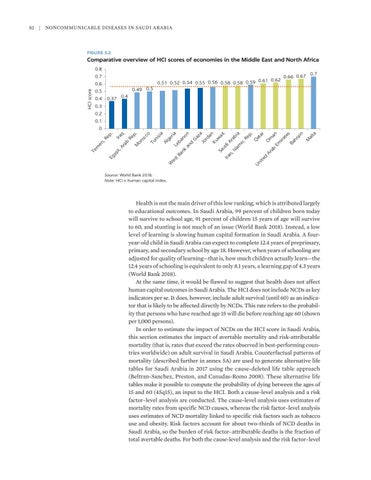82 | Noncommunicable Diseases in Saudi Arabia
FIGURE 5.2
Comparative overview of HCI scores of economies in the Middle East and North Africa 0.8 0.7
0.62 0.51 0.52 0.54 0.55 0.56 0.58 0.58 0.59 0.61
HCI score
0.6 0.5 0.4
0.7 0.66 0.67
0.49 0.5 0.37 0.4
0.3 0.2 0.1
Re p. or oc co Tu ni sia Al ge W ria es L tB eb an an k on an d G az a Jo rd an Ku w Sa ai t ud Ira iA n, r ab Isl ia am ic Re p. Q Un at ar ite d O Ar m ab a Em n ira te s Ba hr ai n M al ta M
ab Ar
Eg yp t,
Ye m
en ,R
ep . Ira q
0
Source: World Bank 2018. Note: HCI = human capital index.
Health is not the main driver of this low ranking, which is attributed largely to educational outcomes. In Saudi Arabia, 99 percent of children born today will survive to school age, 91 percent of children 15 years of age will survive to 60, and stunting is not much of an issue (World Bank 2018). Instead, a low level of learning is slowing human capital formation in Saudi Arabia. A fouryear-old child in Saudi Arabia can expect to complete 12.4 years of preprimary, primary, and secondary school by age 18. However, when years of schooling are adjusted for quality of learning—that is, how much children actually learn—the 12.4 years of schooling is equivalent to only 8.1 years, a learning gap of 4.3 years (World Bank 2018). At the same time, it would be flawed to suggest that health does not affect human capital outcomes in Saudi Arabia. The HCI does not include NCDs as key indicators per se. It does, however, include adult survival (until 60) as an indicator that is likely to be affected directly by NCDs. This rate refers to the probability that persons who have reached age 15 will die before reaching age 60 (shown per 1,000 persons). In order to estimate the impact of NCDs on the HCI score in Saudi Arabia, this section estimates the impact of avertable mortality and risk-attributable mortality (that is, rates that exceed the rates observed in best-performing countries worldwide) on adult survival in Saudi Arabia. Counterfactual patterns of mortality (described further in annex 5A) are used to generate alternative life tables for Saudi Arabia in 2017 using the cause-deleted life table approach (Beltran-Sanchez, Preston, and Canudas-Romo 2008). These alternative life tables make it possible to compute the probability of dying between the ages of 15 and 60 (45q15), an input to the HCI. Both a cause-level analysis and a risk factor–level analysis are conducted. The cause-level analysis uses estimates of mortality rates from specific NCD causes, whereas the risk factor–level analysis uses estimates of NCD mortality linked to specific risk factors such as tobacco use and obesity. Risk factors account for about two-thirds of NCD deaths in Saudi Arabia, so the burden of risk factor–attributable deaths is the fraction of total avertable deaths. For both the cause-level analysis and the risk factor–level

